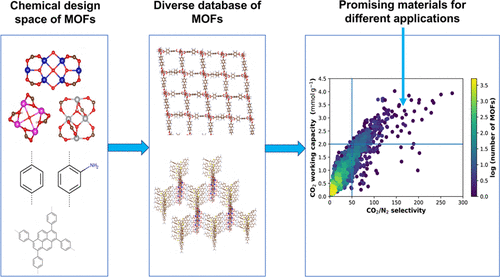S. Majumdar, S. M. Moosavi, K. M. Jablonka, D. Ongari, and B. Smit, Diversifying Databases of Metal Organic Frameworks for High-Throughput Computational Screening ACS Appl. Mater. Interfaces (2021) doi: 10.1021/acsami.1c16220

Abstract: By combining metal nodes and organic linkers, an infinite number of metal organic frameworks (MOFs) can be designed in silico. Therefore, when making new databases of such hypothetical MOFs, we need to ensure that they not only contribute toward the growth of the count of structures but also add different chemistries to the existing databases. In this study, we designed a database of ∼20,000 hypothetical MOFs, which are diverse in terms of their chemical design space─metal nodes, organic linkers, functional groups, and pore geometries. Using machine learning techniques, we visualized and quantified the diversity of these structures. We find that on adding the structures of our database, the overall diversity metrics of hypothetical databases improve, especially in terms of the chemistry of metal nodes. We then assessed the usefulness of diverse structures by evaluating their performance, using grand-canonical Monte Carlo simulations, in two important environmental applications─post-combustion carbon capture and hydrogen storage. We find that many of these structures perform better than widely used benchmark materials such as Zeolite-13X (for post-combustion carbon capture) and MOF-5 (for hydrogen storage). All the structures developed in this study, and their properties, are provided on the Materials Cloud to encourage further use of these materials for other applications.